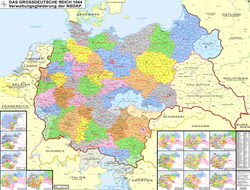Gau Moselland
| Gau Moselland | |||||
| Gau of Nazi Germany | |||||
|
|||||
|
Flag |
|||||
| Capital | Koblenz | ||||
| Gauleiter | |||||
| • | 1931–1945 | Gustav Simon | |||
| History | |||||
| • | 1931 | ||||
| • | Disestablishment | 8 May 1945 | |||
| Today part of |
|
||||
Flag
The Gau Moselland, Gau Koblenz-Trier until January 1942, was an administrative division of Nazi Germany from 1933 to 1945 in the Prussian Rhine Province and, from 1940 onward, the occupied country of Luxembourg. Before that, from 1931 to 1933, it was the regional subdivision of the Nazi Party in that area.
The Nazi Gau (plural Gaue) system was originally established in a party conference on 22 May 1926, in order to improve administration of the party structure. From 1933 onwards, after the Nazi seizure of power, the Gaue increasingly replaced the German states as administrative subdivisions in Germany. The Gau was established in 1931 as Gau Koblenz-Trier and, after the German conquest of Luxembourg in 1940, saw the annexation of the country. In January 1942 it was renamed to Gau Moselland, Mosel being the German name of the river Moselle.
At the head of each Gau stood a Gauleiter, a position which became increasingly more powerful, especially after the outbreak of the Second World War, with little interference from above. Local Gauleiter often held government positions as well as party ones and were in charge of, among other things, propaganda and surveillance and, from September 1944 onward, the Volkssturm and the defense of the Gau.
...
Wikipedia


